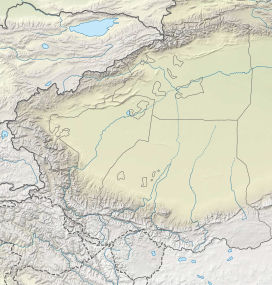Taghdumbash Pamir (Chinese: 塔克敦巴什帕米尔 or historically Chinese: 塔德八士[1]) or Taxkorgan Nature Reserve[2] is a pamir or high valley[3] in the south west of Tashkurgan Tajik Autonomous County, in Xinjiang, China. It lies to the west of the Karakoram Highway. It is inhabited by Wakhi, Kirghiz and Sarikolis animal herders, who graze yaks and other animals on the grasslands of the Pamir.[4]
| Taghdumbash Pamir | |
|---|---|
| Taxkorgan Nature Reserve | |
 | |
| Geography | |
| Location | Taxkorgan Tajik Autonomous County, Xinjiang, China |
| Population centers | Dafdar |
| Coordinates | 37°12′N 75°24′E / 37.200°N 75.400°E |
| Traversed by | Karakoram Highway |
| Taghdumbash Pamir | |||||||
|---|---|---|---|---|---|---|---|
| Traditional Chinese | 塔克敦巴什帕米爾 | ||||||
| Simplified Chinese | 塔克敦巴什帕米尔 | ||||||
| |||||||
| Alternative Chinese name | |||||||
| Traditional Chinese | 塔德八士 | ||||||
| Simplified Chinese | 塔德八士 | ||||||
| |||||||
The name Taghdumbash Pamir is also sometimes applied to the mountain ranges surrounding the Pamir, on the borders of Pakistan, Afghanistan, and Tajikistan with China, straddling the Pamir Mountains along the Sarikol Range, the Hindu Kush, the Mustagh mountains, and the Wakhan. The range divides Badakhshan Province in Afghanistan, Gorno-Badakhshan Autonomous Province in Tajikistan, and Gilgit-Baltistan region in Pakistan.
During the Qing dynasty, the Chinese claimed suzerainty over the area but permitted the Mir of Hunza to administer the region in return for a tribute.[5] According to British colonial sources, this arrangement started during early Ayosh dynasty of Mir of Hunza, as the Mir conquered the Kirghiz nomads of Taghdumbash Pamir.[6] The Mir erected a cairn in Dafdar to evidence his control. The tribute system continued until 1937.[4][5]
In 1984, the pamir and surrounding area was designated Taxkorgan Nature Reserve.[2] Chalachigu Valley, an offshoot of the Taxkorgan Valley is the only place in China where Marco Polo sheep can be found.[7]
References edit
- ^ Ministry of Foreign Affairs (Taiwan) (2001). 外交部檔案叢書: 界務類 [Ministry of Foreign Affairs Archives: Boundary Affairs]. 外交部. p. 54. ISBN 978-957-02-9381-4.
...塔德八士兩地繼續與喀什噶爾之中國當局保持禮物之交換 / Taghdumbash to continue maintain tribute exchange with Chinese authorities at Kashgar
- ^ a b "Taxkorgan Nature Reserve". icimod.org. International Centre for Integrated Mountain Development. Retrieved 2017-02-05.
Basically flat and in places more than 5km wide, the Taxkorgan Valley (the Taghdumbash Pamir on old maps) was part of the ancient Silk Route
- ^ Stein, M. Aurel (1907). Ancient Khotan: Detailed Report of Archaeological Explorations in Chinese Turkestan. Vol. 1. Oxford, UK: Clarendon Press. p. 32.
That part of the valley which properly bears the designation of Taghdumbash Pamir may be said to extend from the Wakhjir Pass to a short distance above Dafdar
- ^ a b Wiener, Gerald; Han, Jianlin; Long, Huijun (June 2003). "Yak keeping in Western High Asia: Tajikistan, Afghanistan, Southern Xinjiang Pakistan, by Hermann Kreutzmann". The Yak (2nd ed.). Bangkok: FAO RAP. ISBN 9251049653.
- ^ a b Christopher Snedden (2015). Understanding Kashmir and Kashmiris. Oxford University Press. p. 119. ISBN 978-1-84904-342-7.
For 200 years, the Mir of Hunza had paid tribute annually to officials of China's Qing/Manchu dynasty located in Kashgar. .. the Mir may have received tribute from a lesser ruler in the Taghdumbash Pamir north of Hunza. Although the Mir of Hunza eventually accepted Dogra suzerainty, the British only forced him to end his tributary relationship with China in 1937
- ^ Ayaz, Muhammad (1927). "Gazetteer of Gilgit". Simla Government of India Press (2nd ed.). Simla: Government of India Press: 85.
In former days Salim Khan, son of Ayasho and ruler of Hunza, marched against the Kirghiz nomads of the Taghdumash Pamir, and in the battle that ensued utterly routed them. In celebration of his victory he erected a cairn of stones at Dafdar, and sent a trophy of Kirghiz heads as present to the Chinese, together with a message that Hunza territory extended as far as Dafdar. Although hitherto Humza had held no intercourse of any kind with the Chinese, the latter returned a present to Salim Khan for having conquered their enemies, and henceforward a custom of an annual interchange of presents between the Chinese and the people of Hunza has prevailed to this day. Hunza has also drawn a yearly tribute in the form of a grazing tax, from all, whether Kirghiz or Sarikuli, who graze in the Taghdumbash.
- ^ USFWS (1990-10-05). "Endangered and Threatened Wildlife and Plants; Proposed Threatened Status for Argali" (PDF). Federal Register. USDOI. Retrieved 2017-02-05.
consisting of fewer than 150 animals, was confined to the western part of the Chalachigu Valley, a finger of land extending between Afghanistan on the north and Pakistan to the south.
External links edit
- Taghdumbash River basin, OpenStreetMap, retrieved 28 January 2023.
- Karachukar River basin, OpenStreetMap, retrieved 28 January 2023.
- Holdich, Thomas Hungerford (1911). . Encyclopædia Britannica. Vol. 20 (11th ed.). pp. 655–659.


